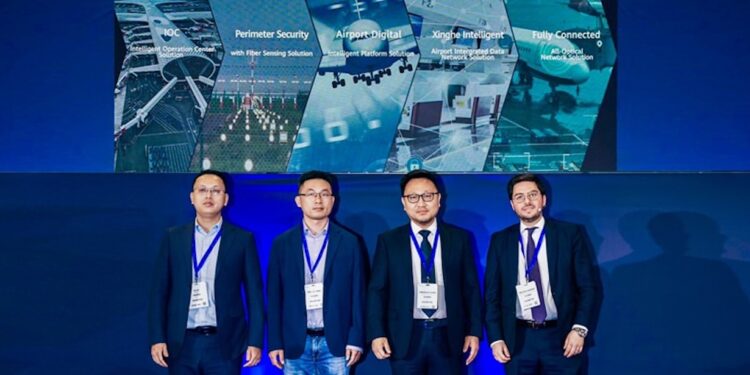During the Passenger Terminal Expo 2025 in Madrid, Huawei launched five aviation solutions, notably including the Smart Airport Intelligent Operation Center (IOC), to advance intelligent industry upgrades. Huawei executives, including Mr. Dong Fangshuo, Vice President of Huawei’s Smart Transportation BU, Mr. Yang Guojie, Director of Transportation Industry Solution Domain from Huawei’s Data Communication Product Line, Eric Liu, Chief Engineer of Huawei Optical Network Business, and Dr. Rachad Nassar, Director of Global Business & Strategic Partners of Huawei’s Smart Transportation BU attended the launch event.
The five solutions unveiled will lay a solid foundation for aviation to “go broadband, go cloud, and go AI.” They are:
- Huawei’s Smart Airport Intelligent Operation Center (IOC) enables precise and efficient decision-making through all-domain situational awareness. With total Airport Management (TAM) concept at its heart, the IOC streamlines management and operations systems and seamlessly connects more than 30 airport production systems, providing a holistic view on one map. Capitalizing on AI algorithms, the IOC accurately predicts the time when an aircraft moves into the stand, optimizes resource allocation, and improves the rate of aircraft docking to jet bridges. This results in a 5% increase in flight departure punctuality and ground support efficiency. The system monitors operation in real time, deploys service resources in advance, proactively handles disruptions, strengthens security management, and improves passenger experience, helping airports go digital and intelligent.
- Huawei’s Smart Airport Perimeter Security Solution with fiber sensing technology elevates airport operational security. Using innovative technologies like Huawei’s distributed optical fiber sensing and AI sensing algorithms, the solution can precisely identify airfield intrusions under harsh weather conditions. It detects the vast majority of intrusions and generates very few false alarms (hundreds of alarms per day reduced to less than 1 alarm/km/day).
- Huawei’s Digital and Intelligent Platform for Airports, based on cloud, data, and AI, makes airport operations smarter, more efficient, and more secure.
- ● Cloud: Core services are migrated to the cloud for active-active deployment, ensuring zero data loss. The recovery time is shortened from 1 hour to just 5 minutes, meeting the 99.99% availability requirement.
- ● Data: The platform builds a comprehensive data governance system alongside a robust data foundation to deliver high-quality data for intelligent applications.
- ● AI: Huawei provides advanced AI capabilities and supports open and compatible mainstream models and engines. Together with its partners, the company looks to create optimal industry models to accelerate aviation intelligence.
- Huawei’s Xinghe Intelligent Airport Integrated Data Network Solution builds a high-quality and highly reliable communication network. Wi-Fi 7 enhances the passenger experience, and with its VIP assurance technology, Wi-Fi 7 improves the bandwidth for VIP passengers by 20%. Huawei’s exclusive Wi-Fi Shield adopts noise superposition to prevent data from being stolen during air interface transmission and protect data. It also automates access authentication and authorization, and can automatically detect and block spoofing and unauthorized access behavior within 30 seconds, eliminating terminal access risks. The solution fully boosts production and operational efficiency and ensures airport networks are stable.
- Huawei’s Smart Airport All-Optical Network utilizes IP + POL (Passive Optical LAN). It introduces the first 10G M45 panel-type Optical Network Unit (ONU) – the OptiXstar P892M – for airports, which supports multiple installation modes such as tabletop, wall embedding, and floor cylinder. One optical fiber allows for integrated access of voice, Wi-Fi, and HD video services, providing more reliable, agile, and green infrastructure to high-quality carry multiple airport service systems.
The solutions reflect that ICT has evolved from a side support system into one of air cargo’s core mission-critical production systems, with intelligence being at the heart of the ongoing transformation of the aviation sector. This evolution is prompting airports to rethink how they allocate resources and evolve toward smart airports. Huawei works with aviation partners to deeply integrate novel technologies and create the architecture of intelligent digital twins that synergize connectivity, cloud, AI, computing, and applications. This architecture aims to significantly enhance operational efficiency, business value, safety, and passenger experience.
Dr. Rachad Nassar, Director of Global Business & Strategic Partners of Huawei’s Smart Transportation BU, noted at the launch event that the advancement of aviation relies on digital and intelligent technologies. He stated that Huawei is committed to building safer and more efficient airport,s providing a seamless experience. “Moving forward, we will collaborate with more industry partners who have best practices to establish a new ecosystem for airport innovation and development. Together, we can help customers streamline existing industry systems, maximize data potential, and improve productivity within the aviation sector.”
During the exhibition, Huawei also showcased its range of scenario-based solutions for airport operations, security, and services alongside airlines’ operating scenarios. The solutions ensure smooth passenger and flight flows, improve travel experience, and increase the operational efficiency of both airports and airlines.
To date, more than 210 airports, airlines, and air traffic management authorities all over the world have chosen Huawei. Looking ahead, Huawei will work with industry customers and partners to build a digital and intelligent foundation for civil aviation, develop smart airports that are safe, green, and passenger-friendly, and accelerate the intelligent development of aviation.
For more information about Huawei’s Smart Aviation Solution, visit: https://e.huawei.com/en/industries/aviation.
Also Read: Why Privacy-First AI is the Key to Responsible Innovation























